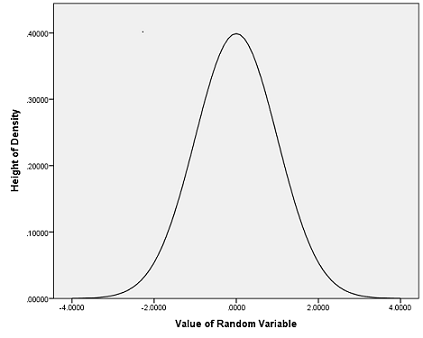The expected value is also called the risk.
Example 13: Suppose the probability that the Bears will the
Super Bowl next year is 1 / 20 = 0.05. You make a bet with your friend.
If the Bears will you get $100. If the bears do not will, you pay him
$10. What is the expected value of this bet?
| Payoff | Probability |
| -10 | 0.95 |
| 100 | 0.05 |
Note: the payoff of 30 in the table is negative because you are
losing $10.
Expected value = (-10) × 0.95 + 100 × 0.05 = -4.5
The conclusion is that you will lose
$4.50 on the average every time
you make this bet.
Example 14: Flip a coin 3 times. You win $10
every time 3 heads come up, you lose $1 every time 1 head comes up
and you lose $5 every time 0 heads come up. Do do not lose or win
anything if 2 heads come up. Compute the expected value.
Ans: Here is the payoff table:
| Payoff | Probablity |
| 10 | 1/8 |
| 0 | 3/8 |
| -1 | 3/8 |
| -5 | 1/8 |
E(x) = 10(1/8) + 0(1/8) + (-1)(3/8) + (-5)(1/8) =
2/8 = $0.25
Example 15: A tropical island has the same probability
distribution for the amount of rain every day:
| Rainfall | Probability |
| 0 | 0.3 |
| 1 | 0.4 |
| 2 | 0.2 |
| 3 | 0.1 |
What is the expected value for the amount of rain in one day?
Ans: E(x) =
x1 p1 +
x2 p2 +
x3 p3 +
x4 p4
= 0 × 0.3 +
1 × 0.4 +
2 × 0.2 +
3 × 0.1 = 1.1
Example 16: You pay $75 per year on a $500,000 house
for insurance. The probability that your house is destroyed in a given
year is 0.0001.
- What is the expected value for the insurance company per year?
Ans: Here is the payout table:
| Payout | Probability |
| 75 | 0.9999 |
| -500,000 + 75 | 0.0001 |
The expected value is
75 × 0.9999 + (-500,000 + 75) × 0.0001 =
75 × (0.9999 + 0.0001) + (-500,000) × 0.0001 =
75 + (-50) = $25.
- What is your risk per year?
Ans: You pay $75 to the insurance company whether or not your house
is destroyed, so the expected value is $-75.
- What would your risk be if you did not have insurance?
Ans: The payout table is
| Payout | Probability |
| 0 | 0.9999 |
| -500,000 | 0.0001 |
The expected value is
0 × 0.9999 + (-500,000) × 0.0001 = -$50.
- What would the "pure premium" to the insurance company be?
The pure premium is the premium you would have to pay if
the expected value of the insurance company were $0.
Ans: Solve for p in the following:
p (0.9999) + (-500,000 + p) 0.0001 = 0. This gives p = 50.
